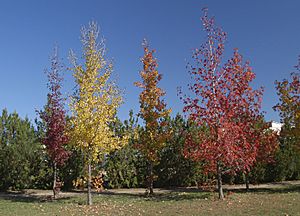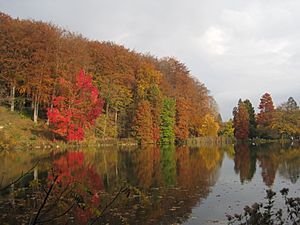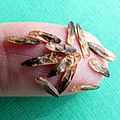American sweetgum facts for kids
Quick facts for kids American sweetgum |
|
|---|---|
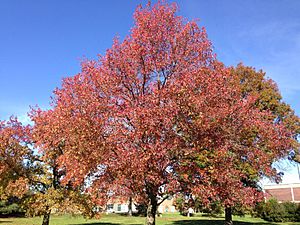 |
|
| Conservation status | |
| Scientific classification | |
| Genus: |
Liquidambar
|
| Species: |
styraciflua
|
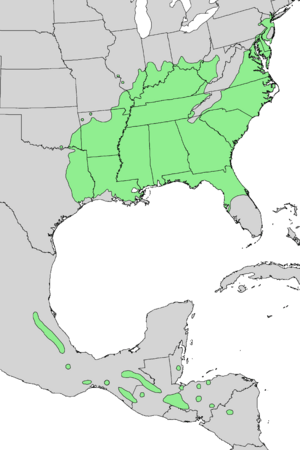 |
|
| Natural range of Liquidambar styraciflua | |
The American sweetgum (Liquidambar styraciflua) is a type of deciduous tree. This means its leaves fall off every autumn. It is found in warm parts of eastern North America, Mexico, and Central America. People also call it American storax, redgum, or just sweetgum.
Sweetgum trees are important for forests in the southeastern United States. They are also popular ornamental trees in places with mild weather. You can easily spot a sweetgum tree by its special five-pointed, star-shaped leaves. These leaves look a bit like maple leaves. Another clue is its hard, spiky fruits.
Contents
What's in a Name?
The name Liquidambar was given by Carl Linnaeus in 1753. It comes from Latin words meaning 'fluid' and 'amber'. This refers to the sticky, sweet-smelling sap or gum that comes out of the tree. The second part of its scientific name, styraciflua, means 'flowing with storax'. Storax is a type of plant resin.
The sweetgum also has a Nahuatl name, Ocotzocuahuitl. This means 'tree that gives pine resin'. It shows how people used the tree's resin long ago.
The common name "sweet gum" describes the tree's "sweetish gum". This helps tell it apart from the black gum tree, which is not closely related. People also call it "red gum" because its bark can look reddish.
A Bit of History
The first known mention of the sweetgum tree was in a book from 1615. A Spanish naturalist named Francisco Hernández de Toledo wrote about it. He described it as a large tree that made a fragrant gum, like liquid amber.
Even earlier, in 1517, Juan de Grijalva wrote about it. He was the nephew of the governor of Cuba. He said the Mayas gave them gifts, including "sweet-smelling liquid amber." They would light it to make a nice smell.
The sweetgum tree first came to Europe in 1681. John Banister, a plant collector, brought it to London, England. He planted it in the palace gardens.
Ancient Sweetgum Trees
Scientists have found very old sweetgum tree fossils. These fossils are from the Tertiary period. They have been found in places like Alaska and Greenland. This shows that sweetgum trees used to grow much farther north than they do today. Similar fossils have also been found in Europe.
Tree Features
How Big Do Sweetgum Trees Get?
Sweetgum trees can grow quite large. In gardens, they usually reach 50–70 feet (15–21 m) tall. In the wild, they can grow up to 150 feet (46 m)! Their trunks can be 2–3 feet (0.61–0.91 m) wide. These trees can live for a very long time, sometimes up to 400 years. When they are young, they often have a nice, egg-shaped crown.
Bark and Branches
The bark of the sweetgum tree is light brown with hints of red and gray. It has deep cracks and scaly ridges. The tree's small branches and twigs are very unique. The bark grows on them in flat plates, making them look a bit like an alligator's skin. This is why some people call the tree "alligatorwood."
The branches also have layers of cork. These "wings" or ridges on the branches can be a problem. They create more surface area, so more snow and ice can build up on the tree. This can make the branches heavy.
Leaves
Sweetgum leaves are easy to recognize. They usually have five (sometimes three or seven) sharp, pointed lobes. This gives them a star shape. They are about 3–5 inches wide.
In summer, the leaves are a shiny, dark green. In autumn, they change into amazing colors. They can turn bright yellow, orange, red, and purple. This autumn display is very beautiful. However, in very cold places, frost can kill the leaves while they are still green. In very warm places, some trees might stay green all year.
Sweetgum leaves look a bit like maple leaves. But you can tell them apart because sweetgum leaves are glossy and leathery. Also, sweetgum leaves grow one by one on the stem (alternate), not in pairs like maple leaves. Some caterpillars, like those of the Luna moth, like to eat sweetgum leaves.
Flowers
Sweetgum flowers usually appear in spring. They are small, about 1–1.5 inches (25–38 mm) across, and greenish. The tree has separate male and female flowers. The male flowers grow in long clusters, and the female flowers grow in a single round head.
Fruit
The sweetgum tree's fruit is very special. It's a hard, dry, round ball, about 1–1.5 inches (25–38 mm) wide. It is made up of many small capsules, usually 40 to 60. Each capsule holds one or two tiny seeds and has a pair of spikes. So, each fruit ball has about 80 to 120 spikes!
When the fruit opens, the seeds are released. The empty fruit balls often fall to the ground. People have many nicknames for them, like "gum balls," "sticker balls," or "spike balls."
These fruit balls hang on the branches through the winter. The seeds inside are small, winged, and spread by the wind. Birds like goldfinches and purple finches eat the seeds. Squirrels and chipmunks also enjoy them.
The spiky sweetgum fruit balls are different from the softer fruit balls of the American sycamore. Sycamore fruits break apart when their seeds are released, but sweetgum fruits stay whole. Walking on fallen sweetgum balls can be uncomfortable, so some places don't allow sweetgum trees to be planted for this reason.
Where Sweetgum Trees Grow
Sweetgum is one of the most common hardwood trees in the southeastern United States. It grows naturally from Connecticut down to central Florida, and west to Illinois and eastern Texas. It does not grow in very cold mountain areas.
The tree also grows in Mexico and Central America. In these regions, it is often found in cloud forests. These are humid, mountainous areas with mild climates. Sweetgum trees are also grown as ornamental trees in Australia.
How People Use Sweetgum
Wood Uses

Sweetgum wood is very important for businesses in the southeastern United States. The wood is a reddish-brown color, with the inner wood sometimes having black streaks. It is heavy and has a nice, smooth feel.
This wood is used for many things. It's a key material for plywood and is called "satin walnut" in the carpentry world. It's used to make furniture, flooring, and parts of buildings like interior trim. It's also used for cigar boxes, crates, and even chopsticks for the East Asian market. The wood is not very strong and can warp when drying, so it's not often used outdoors.
Tree Resin
The sweet, sticky gum or resin that comes from the tree is why it's called "sweetgum." This resin comes out when the tree's bark is cut or damaged. It has many names, like liquid amber or copalm balsam. It smells pleasant, a bit like ambergris.
When the resin gets older, it becomes solid. In the past, people would ship it in barrels. This resin was used as a medicine and also to make chewing gum.
Other Uses
The seeds of the sweetgum tree contain something called shikimic acid. This acid can be used to make certain medicines.
Growing Sweetgum Trees
Sweetgum trees are very popular for planting in gardens and parks. People love them for their unique leaves and amazing autumn colors. They grow well in moist, acidic clay or loam soil. They can also handle soil that doesn't drain perfectly.
However, sweetgum trees don't like very shady areas. If the soil is too alkaline (not acidic enough), their leaves can turn yellow.
There are many different types of sweetgum trees that people have grown. Some have special features:
- 'Burgundy' – Its leaves turn dark red to purple in autumn and can stay that way all winter.
- 'Festival' – This type grows tall and narrow. Its leaves turn yellow, pink, and red in autumn.
- 'Gumball' – This is a small, shrub-like type, usually less than 6 feet tall. Its leaves turn purple-red in autumn.
- 'Moraine' – This type grows fast and has red autumn leaves. It can handle very cold temperatures.
- 'Rotundiloba' – This type has rounded leaf lobes instead of pointed ones. It doesn't produce many seeds.
- 'Slender Silhouette' – This type grows very tall and narrow, like a column.
Sweetgum trees were also planted at the Flight 93 Memorial in Shanksville, Pennsylvania. This was a gift from the organizers of the September 11th Memorial in New York.
Sweetgum Tree Health
Sweetgum trees can sometimes get a leaf spot disease. This disease is caused by a fungus. It makes dark spots on the leaves, often with a reddish ring around them. If there are many spots, they can join together and cause large parts of the leaf to die.
Sometimes, things like herbicides or a lack of iron in the soil can make the trees more likely to get this disease. Sweetgum trees naturally have chemicals called tannins in their healthy tissues. Tannins usually help protect trees from diseases and insects. But for this specific fungus, the tannins don't always stop the infection.
Images for kids
See also
 In Spanish: Liquidámbar para niños
In Spanish: Liquidámbar para niños













